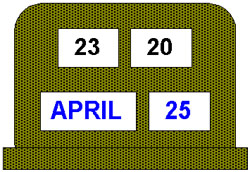The First Attack

German radio announced that "as a reprisal for repeated English air attacks on German towns, Exeter was bombed with severe effect". The use of the word "reprisal" was new and its importance was not immediately noticed by the British. But it signalled the start of the series of raids that were aimed at civilian and architectural targets rather than the military and Government targets which the Germans had concentrated on until then.

 A force of just over 80 bombers was available for the attacks on Bath. Mostly they consisted of the Dornier 17 aircraft (pictured left) which had returned to their temporary bases from the attack on Exeter and the Junkers 88 aircraft (pictured right) which had flown down to France from Holland on the morning of April 25th.
A force of just over 80 bombers was available for the attacks on Bath. Mostly they consisted of the Dornier 17 aircraft (pictured left) which had returned to their temporary bases from the attack on Exeter and the Junkers 88 aircraft (pictured right) which had flown down to France from Holland on the morning of April 25th.
Bletchley Park was also known as Station X. There have been books and a television documentary about the code-breaking activities that took place there.
A coded message was sent to inform the German navigation stations. Decoded, it said "Prepare target tactical number 1467-1".
This message was intercepted and decoded by British Intelligence at Bletchley Park but the target was not identified. They did not know that 1467-1 referred to the Foxhill hutments, so Bath received no warning that an attack was under way.

 R.A.F. coastal stations along the south coast of England detected a number of German planes over Northern France. Fighter Command did not know where these planes were headed, so they scrambled 21 Hurricanes (pictured right) and also 19 Beaufighters (pictured below right) to patrol the coast looking for them, during the next five hours.
R.A.F. coastal stations along the south coast of England detected a number of German planes over Northern France. Fighter Command did not know where these planes were headed, so they scrambled 21 Hurricanes (pictured right) and also 19 Beaufighters (pictured below right) to patrol the coast looking for them, during the next five hours.

The German planes intending to attack Bath began to approach the English Coast from the directions of Lannion and Caen. They were flying at 14000 feet.
 A group of 11 German planes seemed to be headed towards Exeter. A Beaufighter (pictured right) was directed that way. It intercepted and shot down the leading Ju 88 fifteen miles south of Beer Head. Fifteen minutes later, the first of the German bombers crossed the English coast over Bridport. The heavy anti-aircraft guns at Portland and Solent opened fire.
A group of 11 German planes seemed to be headed towards Exeter. A Beaufighter (pictured right) was directed that way. It intercepted and shot down the leading Ju 88 fifteen miles south of Beer Head. Fifteen minutes later, the first of the German bombers crossed the English coast over Bridport. The heavy anti-aircraft guns at Portland and Solent opened fire.

A small number of German aircraft, having lost their way, arrived at the outskirts of Bristol. Thinking they had arrived at Bath, they dropped 200 incendiaries and 50 tonnes of high explosives on that part of Bristol, killing 18 people.
The heavy anti-aircraft guns around Bristol fired their heaviest barrage so far that year.
Chandelier flares fell slowly through the air, giving off a lot of light while they fell, thus making the ground below more visible. Incendiary bombs were quite small, weighing only a kilogram each. They fell quickly and burst into flames when they landed, setting fire to anything flammable that they landed on.

The remaining German bombers reached Bath. In bright moonlight the city was clearly visible. Chandelier flares and incendiaries (see box, right) were dropped first, followed by high explosive bombs. The first bombs that fell were in a straight line stretching from Crescent Gardens to the Gas works. Two gasholders exploded into flames. In addition to the accurate diving attacks with bombs being released from about 4000 feet, the streets were machine-gunned to hamper the work of the emergency services.

A Ju 88, that had got lost and had missed Bath, was in fact flying over Wales.
It was spotted and shot down by Beaufighter near Builth Wells.

The air raid sirens sounded the "All Clear". The first attack on Bath had ended, and the German bombers were heading back to France. One of the returning Dornier Do 17 planes was attacked by a Beaufighter from Tangmere (just east of Chichester and North West of Bognor Regis) and it was badly damaged. It crashed into the sea near Caen.
War Office and Luftwaffe Archives
A local historian, John Penny, researched the RAF records and the Luftwaffe records that survived the war, and prepared a very detailed analysis of exactly what happened during the first attack.
